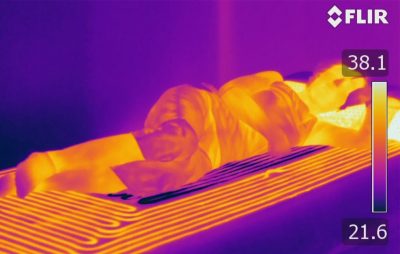
Mattresses seem to be getting more high-tech every day. From the average mattresses on the market now that use a slew of modern materials, like latex, memory foam, or Phase Change Material, to the techiest smart beds out there, mattresses look quite different than they did 50 or 100 years ago.
However, a group of researchers at the University of Texas Austin are trying to make an even more high-tech mattress — not just to add new bells and whistles, but to help you actually fall asleep more quickly, fall asleep at whatever time you want, and even improve your health.
The team has created a temperature-controlled sleep system — essentially, a mattress and pillow that selectively heat and cool areas of the body in order to overall lower your body’s core temperature. Your body naturally lowers its core temperature as a part of its circadian rhythm, but the Texas research team uses selective heating and cooling to “trick” your body into cooling its core temperature, instead of waiting for it to happen naturally.
The researchers recently published a research article in the Journal of Sleep Research that showed this system of selective heating and cooling was effective. They’ve dubbed that system “selective thermal stimulation,” or STS for short. In the paper, the researchers conclude that using STS on participants not only helped them to fall asleep faster, but also resulted in higher sleep quality.
In the study, 11 participants tested the mattresses, going to bed two hours earlier than normal. Some nights they utilized the temperature-control functions and other nights, they did not.
So How Does It Work?
In order to understand how STS works, you first need to take a step back and understand the human body’s natural ability to regulate temperature and how that ties into sleep. Easy enough, right? Just in case you didn’t get an advanced degree in biology, Sleepopolis had Dr. Ken Diller, a biomedical engineering professor at the University of Texas and one of the paper’s authors, break it down.
Diller said the body’s core temperature is medically significant in many ways and being able to manipulate that temperature would be very useful — and not just for sleep (other applications could include fighting infection or maintaining body temperature while under anesthesia). However, our bodies have evolved protective mechanisms that make it difficult to heat or cool the core on demand.
“The primary process by which heat can move from the core inside the body out to the surface where it can be exchanged with the environment, either addition or removal, is via blood flow,” Diller said.
That blood flow runs in two parallel circulatory systems, all powered by the heart. One circulatory system is dedicated to nutrition and immune function. The other is for heat transfer. It’s already known how to easily manipulate the nutritive blood flow system, but the heat transfer one is a little more tricky, Diller told Sleepopolis. The places our bodies do exchange heat with the environment — losing or gaining heat — are areas with arteriovenous anastomoses, or “heat transfer vessels,” as Diller called them.
Our bodies have heat transfer vessels located on areas of hairless skin, Diller said, including the palms of the hands, soles of the feet, ears, and some parts of the face — note, not the core. These areas with heat transfer vessels can get very high blood flow and are where our bodies can lose or take on heat.
A lot of us are intuitively familiar with this. If you’re in a very cold environment, your feet are one of the first parts of you to feel the temperature. That’s because our body’s top priority is maintaining our core temperature. Some commonly known ways the body maintains its temperature include shivering when cold or sweating when hot, but blood flow is actually the most important.
For example, if your body senses that it’s too cold, it will naturally constrict blood flow to areas with heat transfer vessels to protect against heat loss. As Diller said, “The body is very capable, naturally, of defending itself.” However, Diller said, because our bodies are so good at naturally regulating blood flow to control temperature, it’s difficult to manipulate the blood flow to go to heat transfer areas intentionally. That’s where STS comes in.
Using STS to “Trick” Your Body
“Imagine that you are in a room and you set the thermostat in the room on the lowest possible temperature, but you still feel hot,” said Dr. Shahah Haghayegh, a researcher who worked on this study for his PhD. He said STS is like taking a hair dryer and blowing hot air on the thermostat so the thermostat thinks the whole room is hot, triggering it to actually turn on the air conditioning and lowering the room temperature.
“We use the same concept because we need to drop the body temperature to fall asleep,” Haghayegh said. Using the temperature-controlled pillow, the researchers applied a very small amount of heat to the participants’ core — specifically, along the cervical spine. Once the heat is applied, the body is essentially “tricked” into thinking that it’s overheating. Like with cold, our body reacts to being too hot, as it knows that overheating can be fatal.
The temperature sensors in the core detect the body “overheating” and send a signal to increase blood flow to the heat transfer vessels. Redirecting that blood flow to the hands, feet, ears, and other heat transfer areas results in the body’s core temperature dropping.
And what does core temperature dropping correlate to? Sleep onset! With the use of STS, the research team found that their participants were able to fall asleep two hours earlier than their usual bedtime and more quickly than without STS, all by tricking the body into lowering its core temperature more quickly than it would naturally to go to sleep.
In addition to the STS-applying pillow, the mattress prototype used in the research also has temperature controls to maintain that optimal sleeping temperature. The temperature of the mattress surface is cooled down by circulating either water or air.
The peripheral area of the mattress is a little warmer, Haghayegh said, while the central area is cooler. The center is cool to maintain the cooled-down core temperature, but the edges can’t be cooler than the core, otherwise heat won’t transfer from the hands and feet into the environment.
Can’t You Just Wear Socks to Warm Up Your Feet?
If you’re asking that question, don’t worry, because we asked Diller the exact same thing.
Diller said it’s common knowledge that it’s hard to fall asleep when your feet are cold and many people try to solve this problem by wearing socks or using a heating pad on their feet as they go to sleep. The problem, however, is that you’re heating your feet from the outside in.
“If you’re wearing socks, that provides insulation on the outside of your feet. The problem is the inside is cold because the blood flow is vasoconstricted,” Diller said. The same problem happens with the heating pad — you aren’t increasing the blood flow to your feet, or as Diller says, “heating from the inside out.” That blood flow will warm your feet much more effectively than socks or a heating pad could.
Additional Health Benefits of STS
While some of the main metrics the research team studied were related specifically to sleep onset and quality, there are some additional possible health benefits of STS.
Because STS impacts blood flow and the cardiovascular system, it could actually help to lower a sleeper’s blood pressure overnight. Diller compared the cardiovascular system to plumbing, with the heart as the pump and veins like pipes. Like actual plumbing systems, our blood follows the “path of least resistance.”
“When these heat transfer vessels open up and become very large, their resistance to having blood flow through them becomes thousands of times less than it is to go through the capillaries,” Diller said. The decreased resistance basically means your heart doesn’t have to work as hard to pump blood.
When your heart isn’t working as hard, your blood pressure decreases. The head of this STS study, Dr. Ramon Hermida, has conducted previous research on how lowering blood pressure overnight can reduce the risk of cardiovascular disease. Diller is optimistic that STS could have a big impact on improving cardiovascular health across society.
What’s Next For STS?
The team is continuing to work on publishing more STS research papers, but these findings aren’t meant just for the academic world. They hope to partner with a mattress company to bring STS to the masses. Diller and the other researchers on this project are scientists and engineers, not product experts. They hope to combine their research findings with a manufacturers’ product expertise to make the STS mattress a reality.
Diller thinks STS can do better than current cooling mattresses on the market, saying that most of the current models “work from the outside in” — as opposed to STS working from the inside out. Most cooling mattresses on the market now utilize materials like gel, copper, graphite infusions, latex foam, or Phase Change Material to keep the surface cool. Other features like perforations or coils can promote airflow to prevent hot air from being trapped.
“If you can’t control the primary heat transfer blood flow between the core and the surface, you can do all the thermal gymnastics you want to in the surface and it’s not going to have that greater benefit to the core, which is where all the most important action occurs related to health and wellbeing associated with sleep,” Diller said.
“A lot of people are trying to sell temperature with it [current commercial mattress designs], but nobody is doing the essential core temperature control, which is what our patented technology is. That’s what I want to bring to the table,” Diller said.



























